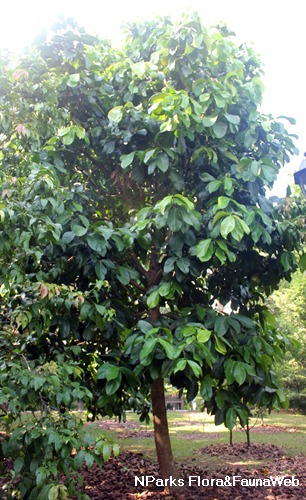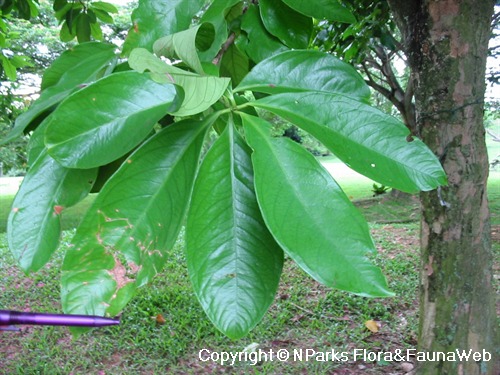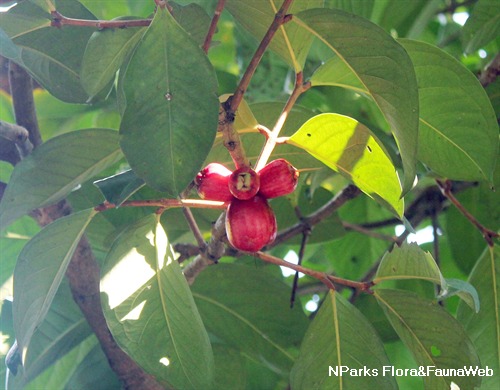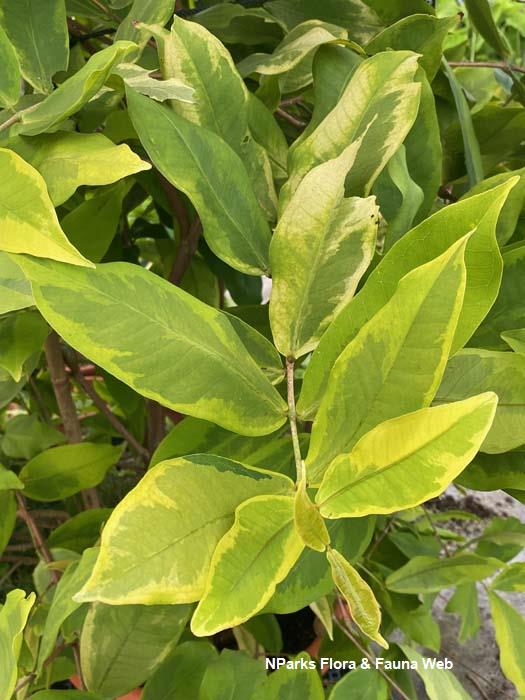
Back
Syzygium malaccense (L.) Merr. & Perry
| Family Name: | Myrtaceae |
| Synonyms: | Eugenia malaccensis L. |
| Common Name: | Jambu Bol, Malay Apple, Pomerac, Jambu Merah |
Name
Classifications and Characteristics
| Plant Division | Angiosperms (Flowering Seed Plants) (Dicotyledon) |
|---|---|
| Plant Growth Form | Tree (Medium (16m-30m), Small (6m-15m)) |
| Lifespan (in Singapore) | Perennial |
| Mode of Nutrition | Autotrophic |
| Maximum Height | 5 m to 20 m |
Biogeography
| Native Distribution | Malaysia, Indonesia |
|---|---|
| Native Habitat | Terrestrial (Riverine) |
| Preferred Climate Zone | Tropical |
Description and Ethnobotany
| Others - Plant Morphology | Growth Form: Small to medium-sized, evergreen tree with a wide, ovoid crown. Habitat: Occurs in moist tropical lowlands at altitudes of 0 - 1200 m. Trunk: Straight trunk is usually low branching (0.2 - 0.45 m wide). Foliage: Opposite leaves are oblong to elliptic with entire leaf margin (15 - 38 cm long, 7 - 20 cm wide). Flowers: Reddish pink, pom-pom shaped flowers (5 - 7 cm wide) are arranged in clusters of 1 - 12 on branches that have shed their leaves. Fruits: Fleshy, ellipsoid fruits known as berries (5 - 8 cm wide) are typically dark red with white or pink streaks, but can also be whitish or yellowish. Each fruit contains 1 round, brown seed (2.5 - 3.5 cm wide). Mature fruits form within 2 months of blooming. Landscaping: This species is grown as a fruit tree in home gardens. It is often planted near streams and ponds, because it requires a consistent supply of water. Cultivation: This species grows best in heavy soils that are well-draining but moist. Trees should be spaced 6 - 8 m apart. Feed with a compound fertilizer after harvesting the fruits. Propagation: Propagate by seed, budding, air layering, grafting and stem cuttings. Propagation by seed is often used. Etymology: The genus name "Syzygium" is derived from the Greek word "suzugos" which means joined. Syzygium used to be the name of a Jamaican plant species with paired leaves and branches. |
|---|---|
| Ethnobotanical Uses | Edible Plant Parts : Edible Fruits Food (Fruit or Vegetable) Others: Food: The fruits are consumed raw or cooked. They are sometimes mixed with other fruits and stewed. Although this species is grown in home gardens for its fruits, it is not grown in commercial orchards. Other: Its hard, reddish wood is sometimes used as timber. |
Landscaping Features
| Thematic Landscaping | Economic Garden |
|---|
Plant Care and Propagation
| Light Preference | Full Sun |
|---|---|
| Water Preference | Moderate Water |
| Plant Growth Rate | Moderate |
| Rootzone Tolerance | Fertile Loamy Soils, Well-Drained Soils |
| Propagation Method | Seed, Stem Cutting, Grafting, Air-Layering |
| Planting Distance | 6 m to 8 m |
Foliar
| Mature Foliage Colour(s) | Green |
|---|---|
| Mature Foliage Texture(s) | Thick |
| Prominent Young Flush Colour(s) | Red |
| Foliar Type | Simple / Unifoliate |
| Foliar Arrangement Along Stem | Opposite |
| Foliar Shape(s) | Non-Palm Foliage (Elliptical, Oblong) |
| Foliar Venation | Pinnate / Net |
| Foliar Margin | Entire |
| Foliar Apex - Tip | Acute |
| Foliar Base | Acute |
| Typical Foliar Area | Mesophyll ( 45cm2 - 182.25 cm2 ), Macrophyll ( 182.25cm2 - 1640.25 cm2 ) |
| Leaf Area Index (LAI) for Green Plot Ratio | 3.0 (Tree - Intermediate Canopy) |
Non - Foliar and Storage
| Trunk Type (Non Palm) | Woody |
|---|---|
| Root Type | Underground (Tap Root) |
Floral (Angiosperm)
| Flower & Plant Sexuality | Bisexual Flowers |
| Flower Colour(s) | Pink |
|---|---|
| Flower Symmetry | Radial |
| Flower Size - Remarks | 5 - 7 cm wide |
| Flowering Period | Hot & Dry Period |
Fruit, Seed and Spore
| Mature Fruit Colour(s) | Red |
|---|---|
| Fruit Classification | Simple Fruit |
| Fruit Type | Fleshy Fruit , Berry |
Image Repository
Others
| Master ID | 1870 |
|---|---|
| Species ID | 3163 |
| Flora Disclaimer | The information in this website has been compiled from reliable sources, such as reference works on medicinal plants. It is not a substitute for medical advice or treatment and NParks does not purport to provide any medical advice. Readers should always consult his/her physician before using or consuming a plant for medicinal purposes. |







